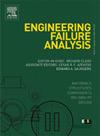Quantitative analysis and optimization of residual stress fields near fastener holes under combined factors
IF 4.4
2区 工程技术
Q1 ENGINEERING, MECHANICAL
引用次数: 0
Abstract
Residual stress surrounding the expanded hole, generated by cold expansion process, plays a pivotal role in enhancing fatigue life but is susceptible to multiple factors. Accurate comprehension of the residual stress field is the essential prerequisite for addressing the fatigue failure problem of fastener holes. In this study, 2D-Digital Image Correlation (DIC) and X-ray Diffraction (XRD) were employed to measure the residual strain and stress of hole plate subjected to split sleeve cold expansion (SSCE) under varying conditions. A 3D finite element (FE) model for tapered mandrel expansion was developed and validated against experimental results. A novel index, termed the effective residual stress, was proposed to quantitatively evaluate the residual stress field. Furthermore, the distribution characteristics of residual stress field were predicted and optimized using machine learning (ML) algorithm, considering the combined effect of the degree of cold expansion (DE), thickness of the plate, and edge distance ratio (EDR). Results indicate a nonlinear relationship between the effective residual stress and both thickness and EDR, and the influence of EDR is greater than thickness. For plates with varying thickness and EDR, the optimal DE varies from 3.5 % to 5.0 %. Specifically, when the EDR is below 3.5 and the thickness is below 10 mm, the optimal DE falls within the range of 3.5 % to 4 %.
求助全文
约1分钟内获得全文
求助全文
来源期刊

Engineering Failure Analysis
工程技术-材料科学:表征与测试
CiteScore
7.70
自引率
20.00%
发文量
956
审稿时长
47 days
期刊介绍:
Engineering Failure Analysis publishes research papers describing the analysis of engineering failures and related studies.
Papers relating to the structure, properties and behaviour of engineering materials are encouraged, particularly those which also involve the detailed application of materials parameters to problems in engineering structures, components and design. In addition to the area of materials engineering, the interacting fields of mechanical, manufacturing, aeronautical, civil, chemical, corrosion and design engineering are considered relevant. Activity should be directed at analysing engineering failures and carrying out research to help reduce the incidences of failures and to extend the operating horizons of engineering materials.
Emphasis is placed on the mechanical properties of materials and their behaviour when influenced by structure, process and environment. Metallic, polymeric, ceramic and natural materials are all included and the application of these materials to real engineering situations should be emphasised. The use of a case-study based approach is also encouraged.
Engineering Failure Analysis provides essential reference material and critical feedback into the design process thereby contributing to the prevention of engineering failures in the future. All submissions will be subject to peer review from leading experts in the field.
 求助内容:
求助内容: 应助结果提醒方式:
应助结果提醒方式:


